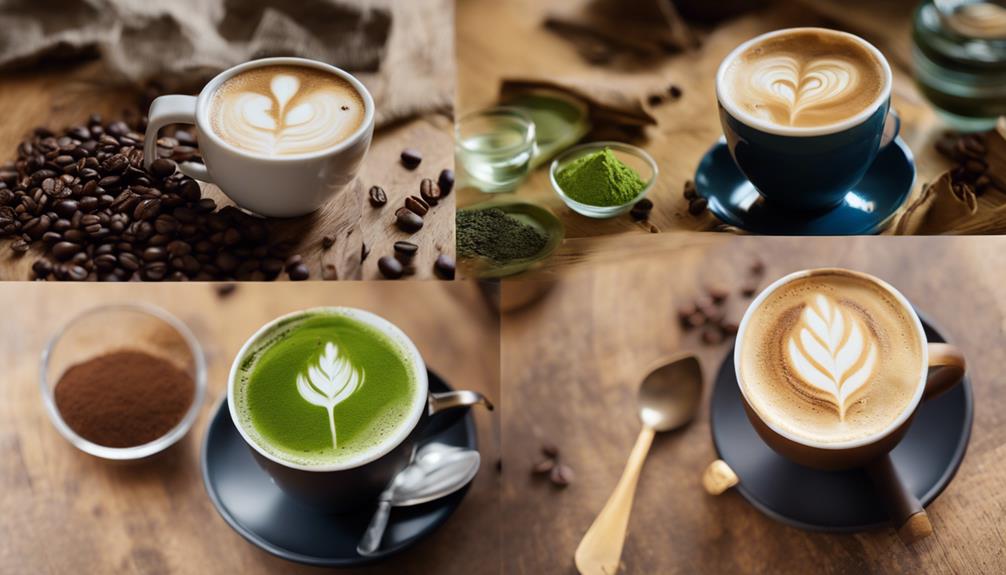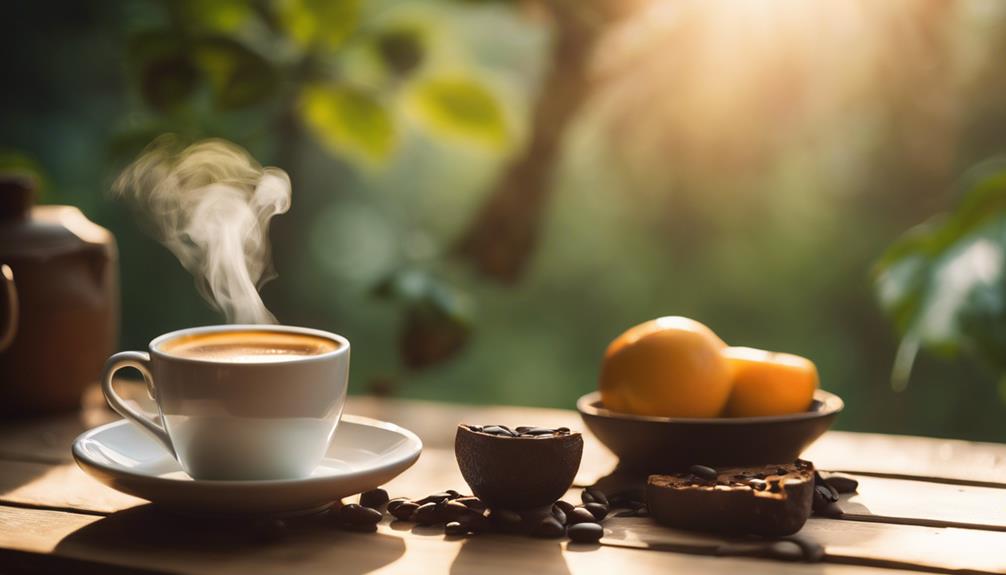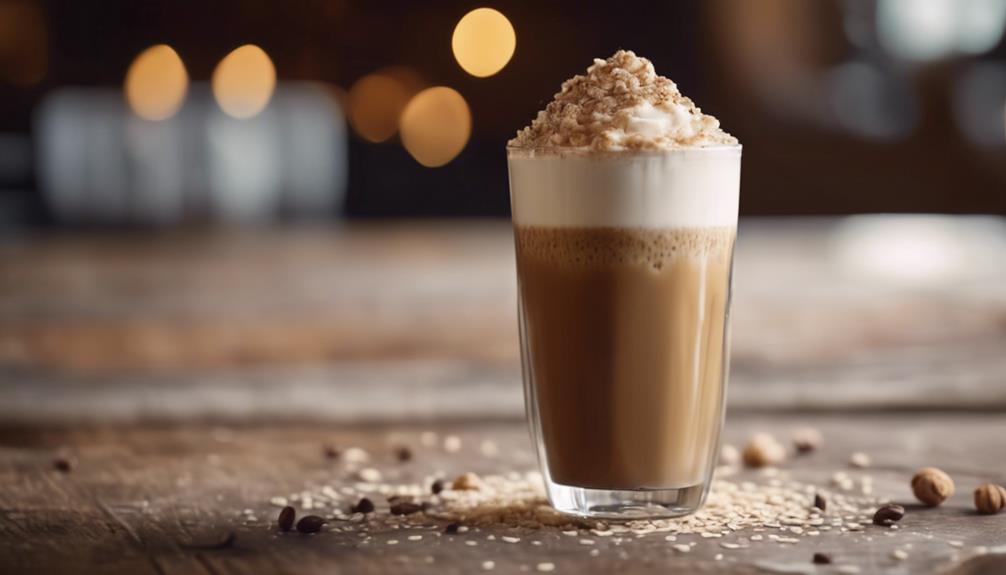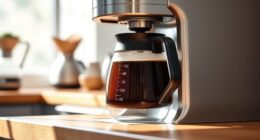You’re probably tired of the anxiety and jitters that accompany your daily coffee routine, and you’re ready for a healthier option that still offers a much-needed energy boost. Fit Espresso is the perfect solution, providing a unique combination of mushroom extracts, adaptogens, and superfoods that deliver sustained energy without any negative side effects. By making the switch to Fit Espresso, you’ll not only steer clear of caffeine’s detrimental effects on your mood and sleep, but also nourish your body with antioxidants and vitamins. As you delve into this healthier alternative to coffee, you’ll uncover a wealth of benefits that will revolutionize your daily routine and overall health.
Key Takeaways
- Fit Espresso offers a unique blend of mushroom extracts, adaptogens, and superfoods, providing energy boosts without jitters.
- Rich in antioxidants and essential nutrients from ingredients like cacao and maca, Fit Espresso supports immune function and overall well-being.
- As a low-acidity option, Fit Espresso is beneficial for individuals with digestive sensitivities, reducing stomach acidity and discomfort.
- By incorporating Fit Espresso into daily habits, individuals can prioritize health and wellness, aligning with their wellness goals.
Quitting Coffee: The Journey
As you initiate the journey of quitting coffee, be prepared to face a range of physical and emotional challenges that will test your resolve, but ultimately lead to a healthier, more balanced you.
You'll likely experience withdrawal symptoms like headaches and fatigue, especially if you stop consuming caffeine suddenly. To ease the change, try reducing your coffee intake gradually or substitute it with lower-caffeine beverages like green tea. This will help your body adjust to the decrease in caffeine.
Exploring healthy alternatives is key to quitting coffee successfully. Look into options like matcha, herbal teas, or smoothies that can provide comforting rituals similar to coffee drinking. These alternatives can help you reduce caffeine dependence while still offering a sense of comfort and relaxation.
As you navigate this journey, remember that you're not alone. Engaging with supportive communities or seeking encouragement from friends can make a significant difference in your progress. Stay motivated, and you'll be on your way to a healthier, coffee-free life.
Health Benefits of Alternatives
You'll be delighted to discover that switching to coffee alternatives can bring a multitude of health benefits, from reduced anxiety and jitters to improved digestive health and immune function.
By opting for lower-caffeine options like herbal teas and matcha, you'll experience a significant decrease in anxiety and jitters. Many coffee substitutes, such as chicory root and dandelion root coffee, are rich in antioxidants and dietary fiber, supporting your digestive health and immune function.
These alternatives often contain beneficial compounds like adaptogens, which can help manage stress and promote overall well-being. Caffeine-free options like roasted dandelion root and grain-based substitutes are gentler on your stomach, reducing acidity and digestive discomfort.
By incorporating these alternatives into your diet, you can expect improved sleep quality and mood stabilization. In fact, individuals who quit coffee have reported better sleep and reduced irritability.
With so many health benefits, it's no wonder coffee alternatives are becoming increasingly popular. Make the switch and start reaping the rewards of a healthier, happier you!
Exploring Coffee Substitutes

With a plethora of options available, you're spoiled for choice when it comes to exploring coffee substitutes that cater to your unique tastes and dietary needs.
If you're looking for a healthy alternative that still provides an energy boost, consider matcha or herbal teas, which offer a natural energy lift with considerably less caffeine.
Or, try chicory root and dandelion root coffee, which are caffeine-free and rich in antioxidants, supporting digestive health while mimicking the taste of coffee.
The growing trend towards plant-based and health-focused beverages has led to innovative coffee substitutes, including grain-based options and mushroom coffee blends.
You can also explore popular plant-based options like MUD\WTR and Dandy Blend, which offer unique flavor profiles and health benefits, appealing to those seeking a nutritious and enjoyable coffee experience without high caffeine levels.
With so many healthy alternatives available, you can find a coffee substitute that not only satisfies your cravings but also supports your overall well-being.
Transitioning to New Habits
As you start changing to new habits, you'll want to tackle the challenges that come with quitting or reducing coffee consumption.
You'll need to find ways to overcome withdrawal symptoms, such as headaches and fatigue, and explore new beverages that satisfy your cravings.
Overcoming Withdrawal Symptoms
By tapering off your coffee habit gradually, you can minimize the dreaded withdrawal symptoms that often accompany a sudden switch to healthier alternatives. This allows your body to adjust to the decrease in caffeine intake, reducing the likelihood of headaches, fatigue, and other unpleasant side effects.
To overcome withdrawal symptoms, remember these essential tips:
- Stay hydrated: Dehydration can exacerbate withdrawal symptoms, so drink plenty of water throughout the day.
- Eat nutrient-rich snacks: Consuming snacks rich in protein and complex carbohydrates can stabilize blood sugar levels, reducing cravings and symptoms associated with caffeine withdrawal.
New Beverage Exploration
Now that you've successfully overcome withdrawal symptoms, you can start exploring new beverage options that will help you change to healthier habits. This new beverage exploration is an exciting time, and you're likely wondering what alternatives can satisfy your taste buds.
You'll be pleased to know that there are several healthy coffee alternatives that offer a similar taste experience to your favorite brew. For instance, matcha and chicory root coffee provide a rich flavor while introducing antioxidants and digestive support.
You can also try substituting coffee with lower-caffeine options like green tea or herbal teas to minimize caffeine intake. To make the shift more enjoyable, stay hydrated and add flavorful twists like cinnamon or vanilla to your new beverages.
Engage in social activities centered around non-coffee drinks, and connect with online communities or friends who share your goals. With their support, you'll find that changing to healthier habits becomes less intimidating and more enjoyable.
The Psychology of Caffeine

As you consider switching to a healthy coffee alternative, you're likely thinking about the psychological effects of caffeine on your daily life.
You might be wondering how caffeine dependence can impact your mood and energy levels.
Let's explore the risks of caffeine dependence and how to manage those pesky mood swings.
Caffeine Dependence Risks
You're likely to experience withdrawal symptoms, such as headaches, fatigue, and irritability, if you suddenly reduce or stop your caffeine intake, especially if you're among the 50% of regular users who've developed a dependence on this stimulant. This is because regular caffeine consumption alters your brain chemistry, leading to a tolerance that requires higher amounts to achieve the same stimulating effects.
As you continue to consume caffeine, you may start to notice *some unwanted side effects*, including:
- Increased anxiety and mood swings, especially if you're consuming high doses (over 400 mg per day)
- Disrupted sleep patterns, contributing to insomnia and a cycle of increased caffeine consumption to counteract daytime fatigue
It's essential to be aware of your caffeine consumption and practice moderation to avoid these negative effects. By being mindful of your intake, you can enjoy the benefits of caffeine while minimizing the risks of dependence and negative psychological effects.
Mood Swing Management
Caffeine's dark side reveals itself in the emotional turmoil of mood swings, which can be triggered or exacerbated by excessive consumption, leading to feelings of anxiety, restlessness, and irritability. You may have experienced this firsthand, feeling like you're on an emotional rollercoaster after consuming too much caffeine. The good news is that you're not alone, and there are ways to manage these mood swings.
Excessive caffeine intake can disrupt your sleep patterns, further impacting your mood stability. To avoid this, consider gradually reducing your caffeine consumption instead of quitting abruptly. This will help mitigate withdrawal effects and promote emotional balance. You might be surprised at how much better you feel without the jitters and anxiety that come with caffeine.
As an alternative, herbal teas can provide a calming effect without the negative side effects of caffeine. By being aware of how your body responds to caffeine, you can make informed choices about your beverage consumption for better psychological well-being.
Take control of your mood swings by making conscious decisions about your caffeine intake, and explore healthier alternatives that work for you.
Nutritious Beverage Options
Exploring nutritious beverage options beyond traditional coffee can greatly benefit your daily routine and overall health. As you seek a healthy alternative, you'll find that Fit Espresso stands out as a top choice. This unique blend of mushroom extracts, adaptogens, and superfoods offers a nutritious beverage option that not only tastes great but also supports your overall well-being.
By choosing Fit Espresso, you'll enjoy a range of benefits, including:
- A boost of energy without the jitters associated with traditional coffee
- A rich source of antioxidants and essential nutrients from natural ingredients like cacao and maca
With Fit Espresso, you can experience the benefits of adaptogens, which help your body adapt to stress and may reduce anxiety levels. This healthy coffee alternative is versatile, easy to incorporate into your daily routine, and can be enjoyed on its own or blended into smoothies. For a stylish coffee setup, you can also try adding Fit Espresso to your favorite latte or cappuccino recipe for an extra boost of energy and focus. The adaptogens in Fit Espresso can also support your immune system and overall well-being, making it a great choice for anyone looking to improve their health and wellness. Whether you’re at home or on the go, Fit Espresso is the perfect choice for a delicious and beneficial coffee experience. To elevate your Fit Espresso experience even further, try creating a delicious freddo espresso recipe by blending it with ice and your choice of milk for a refreshing and energizing treat. The adaptogenic properties of Fit Espresso make it a unique and functional addition to your daily routine, providing a natural way to support your body in managing stress and promoting overall well-being. With its versatility and health benefits, Fit Espresso is the ideal choice for those seeking a flavorful and beneficial coffee alternative.
Embracing a Healthier Lifestyle

As you make the switch to Fit Espresso, you're not only upgrading your daily beverage routine but also taking a proactive step towards embracing a healthier lifestyle.
By choosing this healthy alternative, you're aligning your daily habits with your wellness goals. Fit Espresso's unique blend of adaptogenic herbs and superfoods helps boost your energy levels without the jitters, providing a sustained and natural lift.
As you savor each cup, you're also nourishing your body with antioxidants and vitamins that support immune function and reduce inflammation.
This gentler, low-acidity option is perfect for those with digestive sensitivities or acid reflux issues. By incorporating Fit Espresso into your daily routine, you're promoting mindfulness and well-being.
You're taking control of your health, one cup at a time. With Fit Espresso, you can enjoy the ritual of a warm beverage while knowing you're making a conscious choice to prioritize your health.
Frequently Asked Questions
What Is the Main Ingredient in Fitspresso?
You're wondering what makes Fit Espresso tick, and the answer is organic roasted barley, which provides a coffee-like flavor minus the caffeine.
Do Espresso Pills Work?
You're wondering if those "magic beans" in pill form really give you a boost? Yes, they do! Espresso pills work by rapidly delivering caffeine, which can enhance focus, alertness, and energy, but be mindful of your caffeine sensitivity to avoid jitters.
What Is a Healthier Alternative to Coffee?
When you're looking for a healthier coffee alternative, you'll find options like matcha, chicory root coffee, yerba mate, mushroom coffee, and herbal teas offer unique benefits, such as antioxidants, reduced caffeine, and digestive support, that'll make you feel better than traditional coffee.
What Are the Ingredients to Fit Espresso?
When you're craving a coffee-like flavor without the jitters, you're probably wondering what magic goes into that perfect cup. You'll be happy to know that Fit Espresso blends high-quality roasted grains like barley and rye with chicory root and adaptogens like ashwagandha for a healthy twist.
Conclusion
As you wrap up your journey to ditch coffee, remember that quitting is like shedding a worn-out skin – it's uncomfortable at first, but liberating in the end.
You've discovered the world of alternatives, from fit espresso to nutritious beverages, and learned to harness the power of new habits.
Now, savor the taste of a healthier lifestyle, and let the energizing benefits of your choices course through your veins like a revitalizing stream on a parched summer day.









